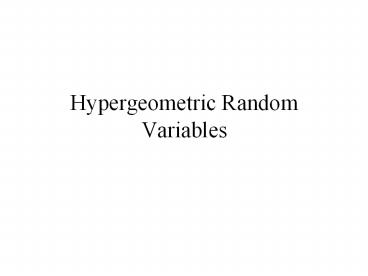Hypergeometric Random Variables - PowerPoint PPT Presentation
1 / 11
Title:
Hypergeometric Random Variables
Description:
Hypergeometric Random Variables Sampling without replacement When sampling with replacement, each trial remains independent. For example, If balls are replaced, P ... – PowerPoint PPT presentation
Number of Views:199
Avg rating:3.0/5.0
Title: Hypergeometric Random Variables
1
Hypergeometric Random Variables
2
Sampling without replacement
- When sampling with replacement, each trial
remains independent. For example, - If balls are replaced, P(red ball on 2nd draw)
P(red ball on 2nd draw first ball was red).
- If balls not replaced, then given the first ball
is red, there is less chance of a red ball on the
2nd draw.
Though for a large population of balls,
the effect may be minimal.
3
n trials, y red balls
- Suppose there are r red balls, and N r other
balls. - Consider Y, the number of red balls in n
selections,where now the trials may be
dependent.(for sampling without replacement,
when sample size is significant relative to the
population) - The probability y of the n selected balls are red
is
4
Hypergeometric R. V.
- A random variable has a hypergeometric
distribution with parameters N, n, and r if its
probability function is given by
where 0 lt y lt min( n, r ).
5
Hypergeometric mean, variance
- If Y is a hypergeometric random variable with
parameter p the expected value and variance for Y
are given by
( Proof not as easy as previous distributions
and is not given at this time. )
6
Sounds like
- If we let p r/N and q 1- p (N - r)/N, then
the hypergeometric measures
Look quite similar to the expressions for the
binomial distribution, E(Y) np and V(Y) npq.
7
Rule of Thumb
- For cases when n / N lt 0.05, it may be
reasonable to approximate the hypergeometric
probabilities using a binomial distribution. - Suppose each hour, 1000 bottles are filled by a
machine and on average 10 are underfilled. - Each hour 20 of the bottles are randomly
selected. Find probability at least 3 of the 20
are underfilled. - Since 20/1000 0.02, perhaps we could use the
binomial distribution to approximate the answer.
8
Easy binomial probability?
- Let p 0.10, the success of underfilling
- P( at least 3 underfilled )
- 1 P( 0, 1, or 2 underfilled) 1 P(Y
0) P(Y 1) P(Y 2) - Approximately equal to 1
binomialcdf(20, 0.10, 2) 0.32307how close is
this to actual hypergeometric?
9
A hypergeometric probability
- P( at least 3 underfilled )
- 1 P( 0, 1, or 2 underfilled) 1 P(Y
0) P(Y 1) P(Y 2)
As compared to 0.32307 using a binomial approx.
10
The Binomial Approximation
The hypergeometric distribution
and a very similar binomial distribution
11
As population increases
- Let N get large as n and pr/N remain constant,
and we would see that
Hypergeometric probabilities converge to the
binomial probabilities, as the events become
almost independent.
Proof ?

